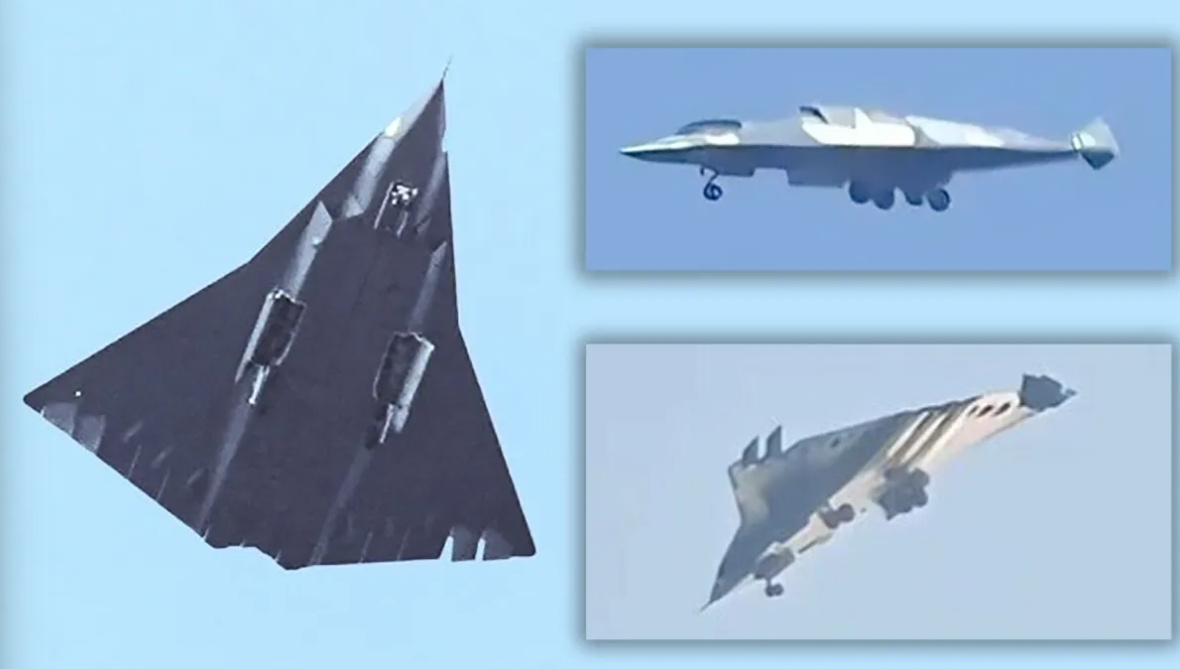
Without a tail and with impressive stealth, Chinese aircraft promise to revolutionize the skies with technology never seen before
In a surprising development, China appears to already be operating a high-performance, stealthy, sixth-generation manned combat aircraft, images of which began to emerge today. At this early stage, we have very little idea about the exact identity of the new aircraft, but many elements of its design are in line with what is already known about Chinese aspirations for sixth-generation air power.
Videos and photos that began circulating on social media today show the never-before-seen aircraft carrying out a daytime test flight, alongside a two-seat Chengdu J-20S fighter, serving as a chase plane. The location and dates of the images cannot yet be verified, although the presence of the J-20 suggests that the Chengdu Aircraft Corporation (CAC) airfield is a likely possibility.

There has so far been no official comment from China’s Ministry of Defense or state media.
In addition to the impressive size of the new aircraft, which we will cover shortly, the most striking aspect is its tailless shape and configuration. It has a modified delta wing with lines extending into the nose area, while its central fuselage section, at least the lower part, vaguely resembles the J-20. The wide nose could even provide space for side-by-side seating for the crew, although the limited views from the cabin mean we can’t be sure whether the aircraft is a single or double seater, with a tandem arrangement being another possibility.



There was already mounting evidence pointing to China’s next fighter jet being tailless, and such designs had appeared before in technical studies. In October 2021, a mysterious tailless aircraft shape appeared in satellite images of a CAC airfield. It was a large modified diamond-shaped delta shape, with a relatively thin front section and also a significant wingspan—broadly similar to that of a J-20. However, it’s worth noting that this shape doesn’t look the same as the aircraft we’re seeing now.
Additionally, next-generation tactical combat aircraft without traditional tailplanes are an important design driver being explored by the U.S. military as well. This predominantly aims to significantly reduce the aircraft’s radar signature across multiple bands and from all angles. There are also some aerodynamic efficiencies to be gained from this type of design, especially for long-range operations, reducing aerodynamic drag, which should provide better performance for sustained high-speed flight and cruising. At the same time, a tailless configuration can adversely affect overall maneuverability, even with the most advanced computerized flight control systems. There are currently no signs of thrust vectoring engines on this aircraft, which would help improve agility and overall stability. The engine exhausts are positioned to mask the aircraft’s infrared signature at the top of the rear fuselage, similar to the YF-23.

While the tailless configuration, size, overall shape and exhaust layout point directly to a design focused on stealth and endurance, it is not entirely clear what exact level of enhanced low observability this new aircraft can offer. Simply removing the tail surfaces and striations and providing more general aerodynamic cleanliness, leveraging nearly 15-year-old technology used on the J-20, for example, would be a significant improvement. Clearly, this aircraft incorporates significantly more advanced low-observable technologies that are beyond the tailless design.
Another notable point is the elaborate control surface arrangement combined with the tailless design, with five trailing edge control surfaces per wing. These include detached flaps near the wing tips, which could be used differentially for yaw control in the absence of tail control surfaces, as well as to simultaneously act as air brakes.

In terms of size, the new aircraft can be compared to the J-20 — images suggest it is at least the same length. The J-20 is about 70 feet from tip to tip. In this aspect, the twin-wheeled main landing gear of this design is also noteworthy, indicating the considerable weight of the aircraft. Above all, its large size appears to reflect an overriding concern for flight endurance, with a relatively large internal volume to accommodate a significant fuel load as well as weapons and sensors.

Perhaps the most unusual feature of the aircraft is its arrangement of air intakes. It appears to have an air intake at the top of the fuselage, as well as twin intakes on each side of the lower fuselage. This has already led to speculation that the aircraft may have a highly unconventional three-engine configuration. Unconfirmed rumors point to a propulsion system consisting of three domestically produced WS-10C turbofans, like those used in the J-20. Considering the aircraft’s greater gross weight compared to the J-20, three engines may be required to meet aggressive performance goals, especially for high-speed sustained flight and high-altitude operations.
It’s no surprise that China is working on a sixth-generation combat aircraft program.
In September 2022, now-retired U.S. Air Force General Mark D. Kelly, then head of Air Combat Command (ACC), stated that China was developing the same type of air combat “system of systems” that its air force was seeking under its Next Generation Air Dominance (NGAD) initiative, including a sixth-generation manned fighter.
At the time, Kelly noted that China viewed sixth-generation airpower, including future manned combat aircraft, “the same way we do: an exponential reduction in signature [de radar]exponential acceleration in processing power and sensing.” Another key factor would be the ability to “iterate” improvements with the help of open mission systems, Kelly added.


Regarding a potential successor to the J-20, Kelly warned that China is “no fool. They know what they are doing.”
Kelly also said he expects China’s sixth-generation air combat program to include an “exponential” improvement in stealth compared to current platforms.
At this early stage, it is not yet clear whether the new aircraft is a sixth-generation fighter prototype or perhaps a more widespread demonstrator that will test new technologies that could potentially be used on a variety of different platforms, including a similar large tactical aircraft. China has almost certainly been involved in preliminary testing of different manned fighter configurations for some time. This development work could include demonstrators, both scaled-down and full-size, and the new aircraft could be well-related to this.

The aircraft could also be linked to a new regional stealth bomber program, which could be a manned component tied to China’s broader sixth-generation airpower initiative.
The regional bomber program, known as JH-XX, remains very secret, but you can read more about what is known about this project here. It was previously thought that Shenyang Aircraft Corporation might be working on the JH-XX, in which case a J-20 chase plane from rival Chengdu would seem less likely.
More likely, at least at this time, this aircraft may be more closely linked to the Chinese version of the United States’ Next Generation Air Dominance initiative, which sought to develop a heavy manned “fighter”-like aircraft that would function both as a node and command and control for drones as well as a classic fighter. Range, sustained speed in cruise, weapons load, and low observability are considered top priorities of the manned fighter component of the NGAD, or at least they were. The hunting element of the program is now on hold and could yet be canceled entirely, or end up looking very different, under the Trump administration.
The fact that this exotic aircraft is flying during the day, in an area where it has apparently been easily photographed, also says a lot about the status of the program. It is very likely that China intended this to be seen at this time.
Overall, although there is still much unknown, what we can definitively say about this aircraft is that it is a large and very heavy tactical jet that placed maximum emphasis on combat communications and survivability. High-altitude operations are also a likely feature of this design, especially if it does indeed feature three engines. Above all, if acquired in operational form by the People’s Liberation Army Air Force (PLAAF), it would be capable of flying long regional distances and remaining at forward stations for long periods without aerial refueling support — something China lacks in terms of of capacity compared to the United States. It would also presumably be capable of operating closer to threats than any other manned aircraft in China’s arsenal.
In other words, it could put air, ground and sea targets at risk in areas where a threat from a manned combat aircraft is not currently expected. This has real implications for American refueling tankers, air carriers, and early warning and control aircraft, as well as allied ships and forces operating in forward locations. It would also serve as a critical sensor platform that operates far ahead. Combined with companion drones of relevant resistance, its lethality and survivability would be multiplied.
In other words, the existence of this aircraft is an event of great importance.
By Thomas Newdick and Tyler Rogoway for TWZ*
Source: https://www.ocafezinho.com/2024/12/26/china-exibe-caca-revolucionario-sem-cauda-video/

